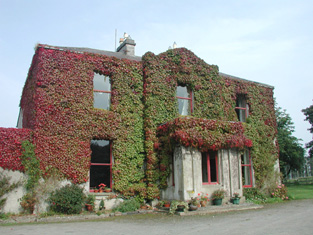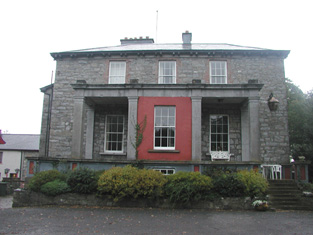Oakfield House (Sligo)
Houses within 5km of this house
Displaying 27 houses.
Houses within 5km of Oakfield House (Sligo)
Displaying 27 houses.
| House name | Description | |
|---|---|---|
| Ellenville or Ardaghowen | The first edition OS Map suggests the house on this site was known at that time as Ellenville. It is now known as Ardaghown, still extant but derelict and was under renovation in 2006. McTernan indicates that it was originally built as a dower house for the Wynne estate. In the 1850s it was held by Owen Wynne from Capt. James Martin and valued at £35. |

|
| Percymount | At the time of Griffith's Valuation John Wynne held this property at Kiltycahill, when it was described as "Painter's house" and valued at £5. The property had been owned by the Gethin family until its sale in the Encumbered Estates Court in the early 1850s. McTernan states that races were frequently held on the lawn at Percymount between the 1870s and the 1940s. The house is now in a derelict condition. | |
| Hazelwood | Hazelwood was designed for Owen Wynne by the architect Richard Castle and built between 1720 and 1740. Reverend William Henry's account of Sligo in 1739 contains a detailed account of the house. Wilson describes it in 1786 as "a fine and elegant seat". It remained the home of the Wynne family for 200 years. At the time of Griffith's Valuation it was owned by John Wynne and was valued at £120. The estate was sold to the Land Commission in the 1920s and the house has had various uses including army accommodation, psychiatric hospital and more latterly, part of an industrial building. Though neglected it survives intact. |

|
| Grange/Primrose Grange | Richard Gethin was leasing a house at Primrose Grange to Christopher Allen at the time of Griffith's Valuation when it was valued at £14. McTernan notes this as Grange House, built in the eighteenth century and enlarged c.1820. It was leased to a succession of families thoroughout the nineteenth and twentieth centuries and was eventually demolished in 1981. A building formerly used as a school is stil extant and lived in. |

|
| Cummeen (also spelt Cummin) | The Ormsby family had a house at Cummeen, Coolera in the eighteenth century. Wilson noted it as the residence of John Ormsby in 1786, when he describes it as "a magniificent and beautiful seat". At the time of Griffith's Valuation the representatives of Charles Ormsby were leasing the house and land at Cumeen to William Phibbs who in turn leased the house to Alexander Wylie. It was valued at £13. Some building remains and a possible folly are still visible at the site. |

|
| Rathcarrick | At the time of Griffith's Valuation there were two substantial houses at Rathcarrick, barony of Carbury, both belonging to the Walker estate. John McHutcheon was leasing one property valued at £18 while Amy Eliza Walker was leasing the second, valued at £28. In 1906 John F. Walker was the owner of a house at Rathcarrick, then valued at £63. Rathcarrick house is still extant and has recently been renovated. |

|
| Cloverhill | Cloverhill was part of the Earl of Erne's estate in county Sligo. At the time of Griffith's Valuation, it was leased to William C. Chambers when it was valued at £28. In 1786 Wilson had noted it as a seat of "Mr. Chalmers" so it had been occupied by that family since the eighteenth century. Cloverhill House was demolished in 1988. Some remains of estate walls visible. | |
| Breeogue | Matthew Walsh was leasing this property from the Earl of Erne's estate at the time of Griffith's Valuation when it was valued at almost £6. Breeogue House is still extant and occupied. |

|
| Kevinsfort | Kevinsfort House was built c.1820. It was the home of various other families at different times in the 19th century, including Capt. George Dodwell. At the time of Griffith's Valuation it seems to have been leased by Alexander Popham to John Stoll and valued at £52. McTernan notes that Popham was Dodwell's son-in-law. The property was sold by the Pophams in 1923. Kevinsfort is still extant and occupied. |

|
| Cleveragh | Capt. James Martin was the lessor of a property valued at £18 at Cleaveragh Demesne, barony of Carbury at the time of Griffith's Valuation. It was being leased by Robert Wilson. It continued in Martin ownership until the twentieth century though frequently occupied by tenants. The house and demesne were eventually bought by Sligo Borough Council with the intention of creating a town park though this was only partially realised. The house was demolished in 1999. | |
| Woodville | Woodville House is still extant and occupied by the Wood family who operate an open farm there. At the time of Griffith's Valuation, it was being leased by Alicia Martin from Capt. James Wood and was valued at £42. |

|
| Rathbraughan | The 1st edition OS map indicates the house at this location was known as Auburn Cottage. At the time of Griffith's Valuation it was occupied by Edward Smith {Smyth] leasing from William Green and valued at £23. McTernan writes that Smyth was the agent for Lord Palmerston's estate. At times it was leased by members of the Gethin family. It was demolished in the 1980s when Rathbraughan housing estate was built. | |
| The Hermitage | At the time of Griffith's Valuation, Harper Campbell was leasing a property at The Mall, Sligo, valued at £41. It had been purchased by him in the Encumbered Estates Court in 1855, having previously been the property of a member of the Wynne family. McTernan notes that it was destroyed by fire in 1976 and the site is now occupied by educational buildings. | |
| Mount Shannon | At the time of Griffith's Valuation, Francis Olpherts was leasing Mount Shannon, barony of Carbury from John Wynne. The house was then valued at £35. McTernan states that Olpherts had recently been appointed agent to the Wynne estate and later married Marianna Wynne of Ardaghowen. The house is still recorded by Slater as being in his possession in 1894. It has had a number of owners since the early twentieth century but is still extant and occupied. |

|
| AbbeyView | At the time of Griffith's Valuation, Alexander Phillips was leasing a house valued at almost £14 at Abbeyquarter North, barony of Carbury, from the Cooper estate. McTernan states that it was built in the later eighteenth century and described in 1878 "as a beautifully situated villa residence with attractive grounds". The Phillips family continued in residence until the 1860s after which it was occupied by a succession of owners until the 1990s when it was sold to the Electricity Supply Board who demolished the house. | |
| Lisnalurg House | George Robinson was leasing Lisnalurg House from the Wynne estate at the time of Griffith's Valuation when it was valued at £14. McTernan notes that it was sometime the accommodation of the estate agent. It is still extant and occupied by descendents of the Wynne family. | |
| Belleview Cottage | Robert Whiteside was leasing the property at Lisnalurg, known as Belleview Cottage from the Wynne estate, at the time of Griffith's Valuation. It was valued at £8. The site is now occupied by a house known as Ardeevin | |
| Summerhill (Carbury) | At the time of Griffith's Valuation, John Gowan was leasing a house valued at £6 at Lisnalurg, from the Wynne estate. This is the house known as Summerhill which, in the 1870s, was acquired by the Anderson family who remained in possession until 1922. It is still extant. | |
| Violet Hill | At the time of Griffith's Valuation Thomas McDonnell was leasing an extensive mill complex and a house at Shannon Oughter, from the Martin estate. The entire property was valued at over £30. | |
| Ballytivnan House | McTernan writes that this was a 2-storey eighteenth century residence, occupied by the Griffith family until the 1830s. Following them it was the home of Jack Taaffe and was damaged on the night of the Big Wind in January 1839. It was later occupied by the Kelly family. Afterwards acquired by the Health authorities and subsequently demolished. | |
| Cairnsfoot | McTernan indicates that Maj. De Bromhead is the reputed builder of Cairnsfoot, probably in the early decades of the nineteenth century, when he leased the lands from the Cooper estate. He had married Judith Wood in 1823. In the 1840s he returned to England and the house was let to a number of different families, notably the O'Connors. In 2004 it was partially destroyed by fire and subsequently demolished. | |
| Rathanna | Col. Knox Barrett held this property from Jane Mullin at the time of Griffith's Valuation when it was valued at £20. It remained in the Barret family until the early 1900s when it was sold to the Monahan family who owned it until the 1960s. McTernan writes that it was sold to the Jurys Hotel Group who built the Sligo Park Hotel in front of the original house which was demolished in the 1980s. | |
| Rathellen | McTernan writes that Rathellen was built at the beginning of the nineteenth century as a dower house for the Wood of Woodville estate.. It was purchased by Henry Lyons in 1860 and remained in the Lyons family until the 1940s. It is still extant but unoccupied. | |
| Rose Hill (Sligo) | McTernan writes that this was originally the residence of Thomas Reed and known as Lakeview. It passed to his son-in-law, Vernon Davys, in the early 1830s. After the 1840s it was leased to a succession of tenants. It was demolished in the 1980s to make way for modern housing. | |
| Lower Shannon House | John Duncan was leasing this property from the Wynne estate at the time of Griffith's Valuation, when it was valued at £10.McTernan notes that it was purchased by his relatives from the Wynne estate in the early twentieth century. The property was sold again in the 1920s to the Donaghy family and continues in their possession. | |
| Finisklin House or Seamount | Built as a seaside residence of the Wood family though frequently leased by them to various other families. In the mid nineteenth century it was the residence of Thomas Mostyn Wood and valued at £11. In the 1870s, McTernan notes that it passed to the land agent Richard St. George Robinson, in whose family it remained until the early twentieth century. It is still extant and has been restored. | |
| Belvoir (Sligo) | Wilson refers to Belvoir, situated on the other side of the Garavogue river from Hazelwood, as the seat of Mr. Ormsby in 1786. By the time of Griffith's Valuation, the property here is held by John Wynne and referred to as "a servant's house", valued at £2 15s. Buildings are still extant at the site. |

